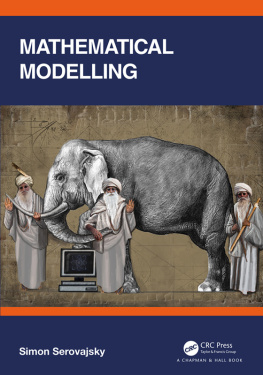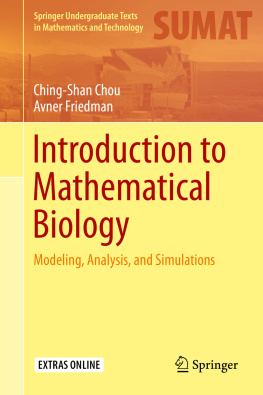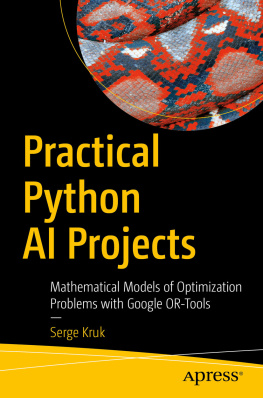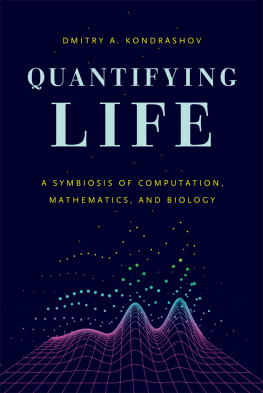A Biologists Guide to
Mathematical Modeling
in Ecology and Evolution
A Biologists Guide to
Mathematical Modeling
in Ecology and Evolution
SARAH P. OTTO
and TROY DAY

Copyright 2007 by Princeton University Press
Published by Princeton University Press, 41 William Street,
Princeton, New Jersey 08540
In the United Kingdom: Princeton University Press, 6 Oxford Street,
Woodstock, Oxfordshire OX20 1TW
All Rights Reserved
Library of Congress Cataloging-in-Publication Data
Otto, Sarah P., 1967
A biologists guide to mathematical modeling in ecology and evolution / Sarah P. Otto and Troy Day.
p. cm.
Includes bibliographical references (p. ).
ISBN-13: 978-0-691-12344-8 (cl : alk. paper)
ISBN-10: 0-691-12344-6 (cl : alk. paper)
1. EcologyMathematical models. 2. Evolution (Biology)Mathematical models. I. Day, Troy, 1968 II. Title.
QH541.15.M3O88 2007
577.015118dc22 2006044774
British Library Cataloging-in-Publication Data is available
This book has been composed in ITC Stone Serif
Printed on acid-free paper.
press.princeton.edu
Printed in the United States of America
10 9 8 7 6 5 4
Cover photos Colin Bates ( www.coastalimageworks.com )
Contents
Preface
Why and How to Read This Book
Mathematics is a subject that most biologists take only in high school and in their first year of college or university. Yet many biologists later come to realize that greater familiarity with mathematics would serve them well: for understanding the papers that they read, for developing new theory to explore their ideas, and for generating appropriate models to interpret data. At that point, it can seem hard to reenter the world of mathematics. This book aims to be the guide to mathematics that biologists need.
Our goal is to teach why mathematics is so useful in biology, how to read and interpret equations, and how to construct and analyze new models. The book is fairly comprehensive, providing a lot of the background material needed to analyze a wide variety of models. Our focus is on developing ecological and evolutionary models that describe how biological systems change over time. That said, most of the techniques presented in the book can be readily applied to model many other phenomena, in biology as well as in other disciplines.
Constructing and analyzing models has been made easier for the average biologist by the advent of computer-aided mathematical tools, including Mathematica, Maple, and Matlab. Such packages are called symbolic software packages and are like fancy calculators that can work with symbols (e.g., x, ex, sin(x)) in addition to numbers. Best of all, these packages know more mathematical rules than any of us ever learned. Symbolic software packages allow biologists to focus on the lessons that a mathematical model can teach, by making many of the calculations involved in modeling much easier. Using these packages nevertheless requires an understanding of the mathematical concepts involved, and it is this conceptual understanding that we hope to foster through this book.
The first six chapters and introduces important concepts in probability theory.
Each chapter begins with a list of chapter goals, describing the major topics to be learned, as well as a list of key concepts, whose descriptions are highlighted in marginal boxes throughout the chapter. Important definitions are set apart from the text in highlighted boxes, as are key recipes and rules that can be used in the construction and analysis of models. Supplementary material for many of the chapters is available on the book website ( http://press.princeton.edu/titles/8458.html ), and provides greater depth of information for selected topics. At the end of each chapter we also provide a list of references that go beyond the material presented.
Mastering the mathematical techniques of this book requires practice, and therefore we have developed several problems at the end of each chapter. In addition, we have developed labs (available at the book website) that model important biological problems using the techniques described in this book, and we provide on-line files showing how to generate the figures of the text using the mathematical software package Mathematica.
For courses in mathematical modeling, we expect it would take a full year to cover all of the material of the text. Nevertheless, an excellent introduction to biomathematics can be gained from the first six chapters, perhaps with a subset of the material presented from the second half (e.g., ).
We are grateful for the advice, corrections, and words of wisdom received from a large number of students and colleagues. In particular, we thank Peter Abrams, Aneil Agrawal, Dilara Ally, Carl Bergstrom, Erin Cameron, Karen Choo, Andy Gardner, Aleeza Gerstein, Dick Gomulkiewicz, Jessica Hill, Ben Kerr, Simon Levin, Andy Peters, Daniel Promislow, Steve Proulx, Ben Roberts, Locke Rowe, Risa Sargent, Tom Sherratt, Jennifer Slater, Chrissy Spencer, Peter Taylor, Franjo Weissing, Geoff Wild, and a number of anonymous reviewers. We are especially grateful to Michael Whitlock for reading and providing detailed comments on the entire book. The Natural Sciences and Engineering Research Council of Canada provided financial support through both their Discovery Research Grant (to SPO and TD) and Steacie Fellowship (to SPO) programs. Special thanks are due to Patrick Phillips, who provided cheerleading when it was most needed, Mark Blows who provided TD with an ideal Australian habitat in the final stages of this book, and to Sam Elworthy, who steered us clear of several pitfalls. Finally, we are indebted to Laura Nagel and Michael Whitlock, whose unflagging support and encouragement allowed this book to be.
Copyright information:
Mathematica is a registered trademark of Wolfram Research.
Maple is a registered trademark of Waterloo Maple Inc.
Matlab is a registered trademark of The MathWorks, Inc.
A Biologists Guide to
Mathematical Modeling
in Ecology and Evolution
CHAPTER 1
Mathematical Modeling in Biology
Chapter Goals:
To develop an appreciation for the importance of mathematics in biology
Chapter Concepts:
Variables
Dynamics
Parameters
Principle of parsimony
1.1 Introduction
Mathematics permeates biology. Unfortunately, this is far from obvious to most students of biology. While many biology courses cover results and insights from mathematical models, they rarely describe how these results were obtained. Typically, it is only when biologists start reading research articles that they come to appreciate just how common mathematical modeling is in biology. For many students, this realization comes long after they have chosen the majority of their courses, making it difficult to build the mathematical background needed to appreciate and feel comfortable with the mathematics that they encounter. This book is a guide to help any student develop this appreciation and comfort. To motivate learning more mathematics, we devote this first chapter to emphasizing just how common mathematical models are in biology and to highlighting some of the important ways in which mathematics has shaped our understanding of biology.
Lets begin with some numbers. According to BIOSIS, 886,101 articles published in biological journals contain the keyword math (including math, mathematical, mathematics, etc.) as of April 2006. Some of these articles are in specialized journals in mathematical biology, such as the
Next page







